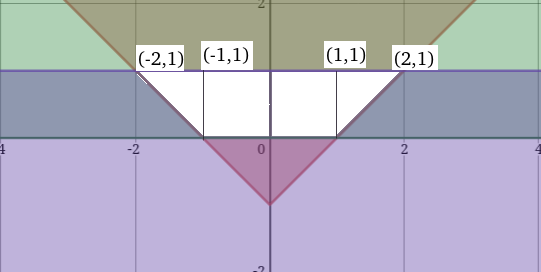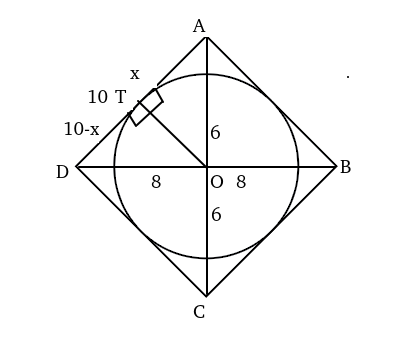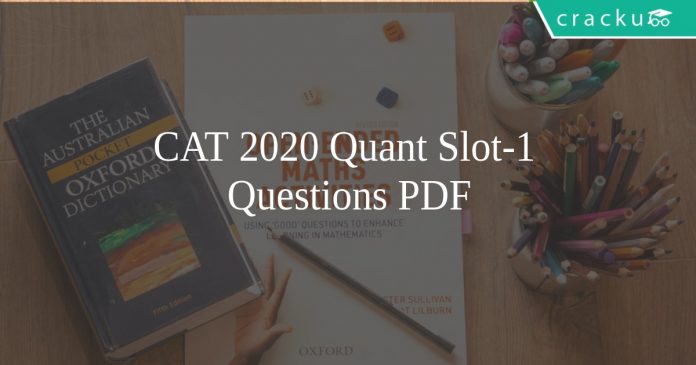CAT 2020 Slot-1 Quantitative Aptitude questions
Download CAT 2020 Slot-1 Quantitative Aptitude questions asked questions in CAT exam. Practice Quantitative Aptitude Questions PDF for CAT exam to understand the type and level of questions asked in the exam..
Download CAT 2020 Quant slot-1 Questions PDF
Watch Video explanations:
Download Free MBA Preparation App
Question 1: If Y is a negative number such that $2^{Y^2({\log_{3}{5})}}=5^{\log_{2}{3}}$, then Y equals to:
a) $\log_{2}(\frac{1}{5})$
b) $\log_{2}(\frac{1}{3})$
c) $-\log_{2}(\frac{1}{5})$
d) $-\log_{2}(\frac{1}{3})$
Question 2: A gentleman decided to treat a few children in the following manner. He gives half of his total stock of toffees and one extra to the first child, and then the half of the remaining stock along with one extra to the second and continues giving away in this fashion. His total stock exhausts after he takes care of 5 children. How many toffees were there in his stock initially?
Question 3: How many 3-digit numbers are there, for which the product of their digits is more than 2 but less than 7?
Question 4: The number of real-valued solutions of the equation $2^{x}+2^{-x}=2-(x-2)^{2}$ is:
a) 1
b) 2
c) infinite
d) 0
Question 5: How many disticnt positive integer-valued solutions exist to the equation $(X^{2}-7x+11)^{(X^{2}-13x+42)}=1$ ?
a) 8
b) 4
c) 2
d) 6
Question 6: A solid right circular cone of height 27 cm is cut into two pieces along a plane parallel to its base at a height of 18 cm from the base. If the difference in volume of the two pieces is 225 cc, the volume, in cc, of the original cone is
a) 243
b) 232
c) 256
d) 264
Question 7: The area of the region satisfying the inequalities $\mid x\mid-y\leq1,y\geq0$ and $y\leq1$ is
Question 8: On a rectangular metal sheet of area 135 sq in, a circle is painted such that the circle touches two opposite sides. If the area of the sheet left unpainted is two-thirds of the painted area then the perimeter of the rectangle in inches is
a) $3\sqrt{\pi}(5+\frac{12}{\pi})$
b) $4\sqrt{\pi}(3+\frac{9}{\pi})$
c) $3\sqrt{\pi}(\frac{5}{2}+\frac{6}{\pi})$
d) $5\sqrt{\pi}(3+\frac{9}{\pi})$
Question 9: A circle is inscribed in a rhombus with diagonals 12 cm and 16 cm. The ratio of the area of circle to the area of rhombus is
a) $\frac{6\pi}{25}$
b) $\frac{5\pi}{18}$
c) $\frac{3\pi}{25}$
d) $\frac{2\pi}{15}$
Question 10: Among 100 students, $x_1$ have birthdays in January, $X_2$ have birthdays in February, and so on. If $x_0=max(x_1,x_2,….,x_{12})$, then the smallest possible value of $x_0$ is
a) 8
b) 9
c) 10
d) 12
Join 30K MBA Aspirants Telegram Group
Question 11: A straight road connects points A and B. Car 1 travels from A to B and Car 2 travels from B to A, both leaving at the same time. After meeting each other, they take 45 minutes and 20 minutes, respectively, to complete their journeys. If Car 1 travels at the speed of 60 km/hr, then the speed of Car 2, in km/hr, is
a) 100
b) 90
c) 80
d) 70
Question 12: A person spent Rs 50000 to purchase a desktop computer and a laptop computer. He sold the desktop at 20% profit and the laptop at 10% loss. If overall he made a 2% profit then the purchase price, in rupees, of the desktop is
Question 13: A solution, of volume 40 litres, has dye and water in the proportion 2 : 3. Water is added to the solution to change this proportion to 2 : 5. If one fourths of this diluted solution is taken out, how many litres of dye must be added to the remaining solution to bring the proportion back to 2 : 3?
Question 14: If $x=(4096)^{7+4\sqrt{3}}$, then which of the following equals to 64?
a) $\frac{x^{7}}{x^{2\sqrt{3}}}$
b) $\frac{x^{\frac{7}{2}}}{x^{\frac{4}{\sqrt{3}}}}$
c) $\frac{x^{\frac{7}{2}}}{x^{2{\sqrt{3}}}}$
d) $\frac{x^{7}}{x^{4\sqrt{3}}}$
Question 15: An alloy is prepared by mixing three metals A, B and C in the proportion 3 : 4 : 7 by volume. Weights of the same volume of the metals A. B and C are in the ratio 5 : 2 : 6. In 130 kg of the alloy, the weight, in kg. of the metal C is
a) 48
b) 84
c) 70
d) 96
Question 16: The number of distinct real roots of the equation $(x+\frac{1}{x})^{2}-3(x+\frac{1}{x})+2=0$ equals
Question 17: If $\log_{4}{5}=(\log_{4}{y})(\log_{6}{\sqrt{5}})$, then y equals
Question 18: Leaving home at the same time, Amal reaches the office at 10:15 am if he travels at 8 km/hr, and at 9:40 am if he travels at 15 km/hr. Leaving home at 9.10 am, at what speed, in km/hr, must he travel so as to reach office exactly at 10 am?
a) 13
b) 12
c) 14
d) 11
Question 19: A train travelled at one-thirds of its usual speed, and hence reached the destination 30 minutes after the scheduled time. On its return journey, the train initially travelled at its usual speed for 5 minutes but then stopped for 4 minutes for an emergency. The percentage by which the train must now increase its usual speed so as to reach the destination at the scheduled time, is nearest to
a) 50
b) 58
c) 67
d) 61
Question 20: The mean of all 4-digit even natural numbers of the form ‘aabb’,where $a>0$, is
a) 4466
b) 5050
c) 4864
d) 5544
How to prepare for PJ and Odd one out
Question 21: Two persons are walking beside a railway track at respective speeds of 2 and 4 km per hour in the same direction. A train came from behind them and crossed them in 90 and 100 seconds, respectively. The time, in seconds, taken by the train to cross an electric post is nearest to
a) 87
b) 82
c) 78
d) 75
Question 22: If a, b and c are positive integers such that ab = 432, bc = 96 and c < 9, then the smallest possible value of a + b + c is
a) 49
b) 56
c) 59
d) 46
Question 23: In a group of people, 28% of the members are young while the rest are old. If 65% of the members are literates, and 25% of the literates are young, then the percentage of old people among the illiterates is nearest to
a) 62
b) 55
c) 59
d) 66
Question 24: Veeru invested Rs 10000 at 5% simple annual interest, and exactly after two years, Joy invested Rs 8000 at 10% simple annual interest. How many years after Veeru’s investment, will their balances, i.e., principal plus accumulated interest, be equal?
Question 25: If $f(5+x)=f(5-x)$ for every real x, and $f(x)=0$ has four distinct real roots, then the sum of these roots is
a) 0
b) 40
c) 10
d) 20
Question 26: Let A, B and C be three positive integers such that the sum of A and the mean of B and C is 5. In addition, the sum of B and the mean of A and C is 7. Then the sum of A and B is
a) 5
b) 4
c) 6
d) 7
Download CAT Previous Papers PDF
Answers & Solutions:
1) Answer (B)
$2^{Y^2({\log_{3}{5})}}=5^{Y^2(\log_3 2)}$
Given, $5^{Y^2\left(\log_32\right)}=5^{\left(\log_23\right)}$
=> $Y^2\left(\log_32\right)=\left(\log_23\right)=>Y^2=\left(\log_23\right)^2$
=>$Y=\left(-\log_23\right)^{\ }or\ \left(\log_23\right)$
since Y is a negative number, Y=$\left(-\log_23\right)=\left(\log_2\frac{1}{3}\right)$
2) Answer: 62
Let the initial number of chocolates be 64x.
First child gets 32x+1 and 32x-1 are left.
2nd child gets 16x+1/2 and 16x-3/2 are left
3rd child gets 8x+1/4 and 8x-7/4 are left
4th child gets 4x+1/8 and 4x-15/8 are left
5th child gets 2x+1/16 and 2x-31/16 are left.
Given, 2x-31/16=0=> 2x=31/16 => x=31/32.
.’. Initially the Gentleman has 64x i.e. 64*31/32 =62 chocolates.
3) Answer: 21
Let the number be ‘abc’. Then, $2<a\times\ b\times\ c<7$. The product can be 3,4,5,6.
We can obtain each of these as products with the combination 1,1, x where x = 3,4,5,6. Each number can be arranged in 3 ways, and we have 4 such numbers: hence, a total of 12 numbers fulfilling the criteria.
We can factories 4 as 2*2 and the combination 2,2,1 can be used to form 3 more distinct numbers.
We can factorize 6 as 2*3 and the combination 1,2,3 can be used to form 6 additional distinct numbers.
Thus a total of 12 + 3 + 6 = 21 such numbers can be formed.
4) Answer (D)

The graphs of $2^{x}+2^{-x} and 2-(x-2)^{2}$ never intersect. So, number of solutions=0.
Alternate method:
We notice that the minimum value of the term in the LHS will be greater than or equal to 2 {at x=0; LHS = 2}. However, the term in the RHS is less than or equal to 2 {at x=2; RHS = 2}. The values of x at which both the sides become 2 are distinct; hence, there are zero real-valued solutions to the above equation.
5) Answer (D)
$(X^{2}-7x+11)^{(X^{2}-13x+42)}=1$
if $(X^{2}-13x+42)$=0 or $(X^{2}-7x+11)$=1 or $(X^{2}-7x+11)$=-1 and $(X^{2}-13x+42)$ is even number
For X=6,7 the value $(X^{2}-13x+42)$=0
$(X^{2}-7x+11)$=1 for X=5,2.
$(X^{2}-7x+11)$=-1 for X=3,4 and for X=3 or 4, $(X^{2}-13x+42)$ is even number.
.’. {2,3,4,5,6,7} is the solution set of X.
.’. X can take six values.
6) Answer (A)

Let the base radius be 3r.
Height of upper cone is 9 so, by symmetry radius of upper cone will be r.
Volume of frustum=$\frac{\pi}{3}\left(9r^2\cdot27-r^2.9\right)$
Volume of upper cone = $\frac{\pi}{3}.r^2.9$
Difference= $\frac{\pi}{3}\cdot9\cdot r^2\cdot25=225$ => $\frac{\pi}{3}\cdot r^2=1$
Volume of larger cone = $\frac{\pi}{3}\cdot9r^2\cdot27=243$
7) Answer: 3

The area of the region contained by the lines $\mid x\mid-y\leq1,y\geq0$ and $y\leq1$ is the white region.
Total area = Area of rectangle + 2 * Area of triangle = $2+\left(\frac{1}{2}\times\ 2\times\ 1\right)\ =3$
Hence, 3 is the correct answer.
8) Answer (A)

Let ABCD be the rectangle with length 2l and breadth 2b respectively.
Area of the circle i.e. area of painted region = $\pi\ b^2$.
Given, 4lb-$\pi\ b^2$=(2/3)$\pi\ b^2$.
=> 4lb=(5/3)$\pi\ b^2$.
=>l=$\frac{5\pi}{12}b$.
Given, 4lb=135 => 4*$\frac{5\pi}{12}b^2$=135 => b= $\frac{9}{\sqrt{\ \pi\ }}$
=> l=$\frac{15}{4}\sqrt{\ \pi\ }$
Perimeter of rectangle =4(l+b)=4($\frac{15}{4}\sqrt{\ \pi\ }$+$\frac{9}{\sqrt{\ \pi\ }}$ )=$3\sqrt{\pi}(5+\frac{12}{\pi})$.
Hence option A is correct.
9) Answer (A)

Let the length of radius be ‘r’.
From the above diagram,
$x^2+r^2=6^2\ $….(i)
$\left(10-x\right)^2+r^2=8^2\ $—-(ii)
Subtracting (i) from (ii), we get:
x=3.6 => $r^2=36-\left(3.6\right)^2$ ==> $r^2=36-\left(3.6\right)^2\ =23.04$.
Area of circle = $\pi\ r^2=23.04\pi\ $
Area of rhombus= 1/2*d1*d2=1/2*12*16=96.
.’. Ratio of areas = 23.04$\pi\ $/96=$\frac{6\pi}{25}$
10) Answer (B)
$x_0=max(x_1,x_2,….,x_{12})$
$x_0$ will be minimum if x1,x2…x12 are close to each other
100/12=8.33
.’. max$(x_1,x_2,….,x_{12})$ will be minimum if $(x_1,x_2,….,x_{12})$=(9,9,9,9,8,8,8,8,8,8,8,8,)
.’. Option B is correct.
Download CAT Previous Solved Papers
Free Live Classes – Cracku Youtube
11) Answer (B)
Let the speed of Car 2 be ‘x’ kmph and the time taken by the two cars to meet be ‘t’ hours.
In ‘t’ hours, Car 1 travels $\left(60\ \times\ t\right)\ km$ while Car 2 travels $\left(x\ \times\ t\right)\ km$
It is given that the time taken by Car 1 to travel $\left(x\ \times\ t\right)\ km$ is 45 minutes or (3/4) hours. $\therefore\ \frac{\left(x\ \times\ t\right)}{60}\ =\ \frac{3}{4}\ $ or $t=\frac{180}{4x}$….(i)
Similarly, the time taken by Car 2 to travel $\left(60\ \times\ t\right)\ km$ is 20 minutes or (1/3) hours. $\therefore\ \frac{\left(60\times\ t\right)}{x}=\frac{1}{3}$ or $\therefore\ t=\frac{x}{180}$….(ii)
Equating the values in (i) and (ii), and solving for x:
$\therefore\ \frac{180}{4x}=\frac{x}{180}\ \ \longrightarrow\ \ \ x\ =90\ kmph$
Hence, Option B is the correct answer.
12) Answer: 20000
Let the price of desktop and laptop be x,y respectively.
Given,
x+y=50000…(i)
12.x+0.9y=50000(1.02)=51000…(ii)
(ii)-0.9(i) gives
0.3x=6000=> x=20000.
13) Answer: 8
Initially the amount of Dye and Water are 16,24 respectively.
To make the ratio of Dye to Water to 2:5 the amount of water should be 40l for 16l of Dye=> 16l of water is added.
Now, the Dye and Water arr 16,40 respectively.
After removing 1/4th of solution the amount of Dye and Water will be 12,30l respectively.
To have Dye and Water in the ratio of 2:3, for 30l of water we need 20l of Dye => 8l of Dye should be added.
Hence , 8 is correct answer.
14) Answer (C)
$x=2^{12\left(7+4\sqrt{\ 3}\right)}$.
$x^{\frac{7}{2}}=2^{42\left(7+4\sqrt{\ 3}\right)}$
$x^{2\sqrt{\ 3}}=2^{24\sqrt{\ 3}\left(7+4\sqrt{\ 3}\right)}$
$\frac{x^{\frac{7}{2}}}{x^{2{\sqrt{3}}}}$ = $2^{\left(7+4\sqrt{\ 3}\right)\left(42-24\sqrt{\ 3}\right)}=2^{\left(7+4\sqrt{\ 3}\right)\left(7-4\sqrt{\ 3}\right)6}$ =$2^6$.
Hence C is correct answer.
15) Answer (B)
Let the volume of Metals A,B,C we 3x, 4x, 7x
Ratio weights of given volume be 5y,2y,6y
.’. 12xy+8xy+42xy=130 => 65xy=130 => xy=2.
.’.`The weight, in kg. of the metal C is 42xy=84.
Join Telegram group of MBA aspirants
16) Answer: 1
Let $a=x+\frac{1}{x}$
So, the given equation is $a^2-3a+2=0$
So, $a$ can be either 2 or 1.
If $a=1$, $x+\frac{1}{x}=1$ and it has no real roots.
If $a=2$, $x+\frac{1}{x}=2$ and it has exactly one real root which is $x=1$
So, the total number of distinct real roots of the given equation is 1
17) Answer: 36
$\frac{\log\ 5}{2\log2}\ =\frac{\log\ y}{2\log2}\cdot\frac{\log\ 5}{2\log6}$
$\log\ 36\ =\ \log\ y;\ \therefore\ y\ =36$
18) Answer (B)
The difference in the time take to traverse the same distance $’d’$ at two different speeds is 35 minutes. Equating this: $\frac{d}{8}-\frac{d}{15}\ =\ \frac{35}{60}$
On solving, we obtain $d = 10 kms$. Let $x kmph$ be the speed at which Amal needs to travel to reach the office in 50 minutes; then
$\frac{10}{x}=\frac{50}{60}\ or\ x\ =\ 12\ kmph$.Hence, Option B is the correct answer.
19) Answer (C)
Let the total distance be ‘D’ km and the speed of the train be ‘s’ kmph. The time taken to cover D at speed d is ‘t’ hours. Based on the information: on equating the distance, we get $s\ \times\ t\ =\ \frac{s}{3}\times\ \left(t+\frac{1}{2}\right)$
On solving we acquire the value of $\ t\ =\frac{1}{4}$ or 15 mins. We understand that during the return journey, the first 5 minutes are spent traveling at speed ‘s’ {distance traveled in terms of s = $\ \frac{s}{12}$}. Remaining distance in terms of ‘s’ = $\ \frac{s}{4}-\frac{s}{12}\ =\frac{s}{6}$
The rest 4 minutes of stoppage added to this initial 5 minutes amounts to a total of 9 minutes. The train has to complete the rest of the journey in $15 – 9 = 6 mins$ or {1/10 hours}. Thus, let ‘x’ kmph be the new value of speed. Based on the above, we get $\frac{s}{\frac{6}{x}}\ =\frac{1}{10}\ or\ x\ =\frac{10s}{6}$
Since the increase in speed needs to be calculated: $\frac{\left(\frac{10s}{6}\ -s\right)}{s}\times\ 100\ =\frac{200}{3}\approx\ 67\%$ increase.
Hence, Option C is the correct answer.
20) Answer (D)
The four digit even numbers will be of form:
1100,1122,1144…1188,2200,2222,2244….9900,9922,9944,9966,9988
Their sum ‘S’ will be (1100+1100+22+1100+44+1100+66+1100+88)+(2200+2200+22+2200+44+…)….+(9900+9900+22+9900+44+9900+66+9900+88)
=> S=1100*5+(22+44+66+88)+2200*5+(22+44+66+88)….+9900*5+(22+44+66+88)
=> S=5*1100(1+2+3+…9)+9(22+44+66+88)
=>S=5*1100*9*10/2 + 9*11*20
Total number of numbers are 9*5=45
.’. Mean will be S/45 = 5*1100+44=5544.
Option D
Download CAT Maths formulas PDF
21) Answer (B)
Let the length of the train be $ l kms$ and speed be $ s kmph$. Base on the two scenarios presented, we obtain:
$\frac{l}{s-2}=\frac{90}{3600}$….(i) and $\frac{l}{s-4}=\frac{100}{3600}$…(ii)
On dividing (ii) by (i) and simplifying we acquire the value of $s$ as $22 kmph$. Substituting this value in (i), we have $l=\frac{90}{3600}\times\ 20\ kms$ {keeping it in km and hours for convenience}
Since we need to find $\frac{l}{s}$, let this be equal to $x$. Then, $x\ =\ 90\times\frac{20}{22}\ =81.81\ \approx\ 82\ \sec onds\ $
Hence, Option B is the correct choice.
22) Answer (D)
Since $c<9$, we can have the following viable combinations for $b\times\ c\ =96$ (given our objective is to minimize the sum):
$48\times\ 2$ ; $32\times3$ ; $24\times\ 4$ ; $16\times6$ ; $12\times8$
Similarly, we can factorize $a\times\ b\ = 432$ into its factors. On close observation, we notice that $18\times24\ and\ 24\ \times\ 4\ $ corresponding to $a\times b\ and\ b\times\ c\ $ respectively together render us with the least value of the sum of $a+b\ +\ c\ \ =\ 18+24+4\ =46$
Hence, Option D is the correct answer.
23) Answer (D)
Let ‘x’ be the strength of group G. Based on the information, $0.65x$ constitutes of literate people {the rest $0.35x$ = illiterate}
Of this $0.65x$, 75% are old people =(0.75)0.65x old literates. The total number of old people in group G is $0.72x$ {72% of the total}. Thus, the total number of old people who are illiterate = $0.72x-0.4875x\ =\ 0.2325x$. This is $\frac{0.2325x}{0.35x}\times\ 100\ \approx\ \ 66\%$ of the total number of illiterates. Hence, Option D is the correct answer.
24) Answer: 12
Let their individual Amounts be equal after ‘t’ years. Let their initial investments amount to $A_V$ and $A_J$ ;
$A_V\ =10,000\left(1+\frac{5t}{100}\right)$ and $A_J\ =8,000\left(1+\frac{10\left(t-2\right)}{100}\right)$
Equating both: $10,000\left(1+\frac{5t}{100}\right)\ =8,000\left(1+\frac{10\left(t-2\right)}{100}\right)$
On simplifying both sides, we get: $15t\ =\ 180\ ;\ t\ =\ 12$
25) Answer (D)
Let ‘r’ be the root of the function. It follows that f(r) = 0. We can represent this as $f\left(r\right)=f\left\{5-\left(5-r\right)\right\}$
Based on the relation: $f\left(5-x\right)=f\left(5+x\right)$; $f\left(r\right)=f\left\{5-\left(5-r\right)\right\}=f\left\{5+\left(5-r\right)\right\}$
$\therefore\ f\left(r\right)=f\left(10-r\right)$
Thus, every root ‘r’ is associated with another root ‘(10-r)’ [these form a pair]. For even distinct roots, in this case four, let us assume the roots to be as follows: $r_1,\ \left(10-r_1\right),\ r_2,\ \left(10-r_2\right)$
The sum of these roots = $r_1\ +\left(10-r_1\right)+\ r_2+\ \left(10-r_2\right)\ =\ 20$
Hence, Option D is the correct answer.
26) Answer (C)
Given
A+(B+C)/2=5 => 2A+B+C=10….(i)
(A+C)/2 +B=7 => A+2B+C=14…..(ii)
(i)-(ii)=> B-A=4 => B=4+A.
Given, A, B, C are positive integers
If A=1=>B=5 => C=3
If A=2=>B=6 => C=0 but this is invalid as C is positive.
Similarly if A>2 C will be negative and cases are not valid.
Hence, A+B=6.
We hope this for CAT 2020 Slot-1 Quantitative Aptitude questions pdf with Solutions will be helpful to you.




![CAT Averages Questions PDF [Important Questions] CAT AVERAGES Questions PDF](https://cracku.in/blog/wp-content/uploads/2022/07/CAT-AVERAGES-Questions-PDF-218x150.png)
